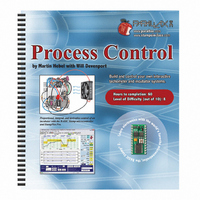122-28176 Parallax Inc, 122-28176 Datasheet - Page 263

122-28176
Manufacturer Part Number
122-28176
Description
GUIDE STUDENT PROCESS CONTROL
Manufacturer
Parallax Inc
Specifications of 122-28176
Accessory Type
Manual
Product
Microcontroller Accessories
Lead Free Status / RoHS Status
Contains lead / RoHS non-compliant
For Use With/related Products
Propeller Education (PE) Kit
Lead Free Status / RoHS Status
Lead free / RoHS Compliant, Contains lead / RoHS non-compliant
- Current page: 263 of 330
- Download datasheet (11Mb)
Chapter 8: Proportional-Integral-Derivative Control · Page 253
By using a circuit similar to the one in Figure 8-4 to perform the measurements,
calculations, and drive, the position of the ball is continuously evaluated and drive is
updated nearly instantaneously. The difference between setpoint and actual voltages is
determined (Error) and this signal is processed with three op-amp configurations to
amplify the error (proportional), measure the error over time (integral) and the change in
error in respect to time (derivative). The three signals and a bias voltage are added
together (summing) to provide a drive voltage. The error instantaneously causes a
change in the output. By adjusting the resistances for each op-amp stage, the gain, and
consequently the contribution to the total output voltage, of the individual P, I and D
blocks may be adjusted to achieve stable operation.
While newer advances in digital technology, such as Digital Signal Processors (DSP) can
come very close to continuous measurement and control of the analog control circuit in
Figure 8-4, programmable microcontrollers such as the BASIC Stamp are limited in the
speed in which the value may be measured, calculations made, and action taken.
Consider the flowchart in Figure 8-5. Code must be processed at each step, which takes
time.
Sampling can only be performed at discrete intervals of time instead of
continuously. The speed of the sampling and evaluation needed is very dependent on the
dynamics of the system under control. Keeping a ball floating requires relatively fast
sampling and control (around 30 updates per second). Other systems, such as our
incubator, have lower demands.
Related parts for 122-28176
Image
Part Number
Description
Manufacturer
Datasheet
Request
R

Part Number:
Description:
MANUAL FOR SUMOBOT
Manufacturer:
Parallax Inc
Datasheet:

Part Number:
Description:
GUIDE STUDENT SMART SENSORS
Manufacturer:
Parallax Inc
Datasheet:

Part Number:
Description:
MANUAL PROPELLER
Manufacturer:
Parallax Inc
Datasheet:

Part Number:
Description:
LEAD WIRES FLYING CABLE III/IV
Manufacturer:
Xilinx Inc
Datasheet:

Part Number:
Description:
BOARD ADAPTER AND FLY LEADS
Manufacturer:
Xilinx Inc
Datasheet:

Part Number:
Description:
PLATFORM CABLE USB II
Manufacturer:
Xilinx Inc
Datasheet:

Part Number:
Description:
KIT STARTER COOLRUNNER-II BUNDLE
Manufacturer:
Xilinx Inc
Datasheet:

Part Number:
Description:
Microcontroller Modules & Accessories DISCONTINUED BY PARALLAX
Manufacturer:
Parallax Inc

Part Number:
Description:
Microcontroller Modules & Accessories DISCONTINUED BY PARALLAX
Manufacturer:
Parallax Inc

Part Number:
Description:
BOOK UNDERSTANDING SIGNALS
Manufacturer:
Parallax Inc
Datasheet:

Part Number:
Description:
BOARD EXPERIMENT+LCD NX-1000
Manufacturer:
Parallax Inc
Datasheet:

Part Number:
Description:
IC MCU 2K FLASH 50MHZ SO-18
Manufacturer:
Parallax Inc
Datasheet:












